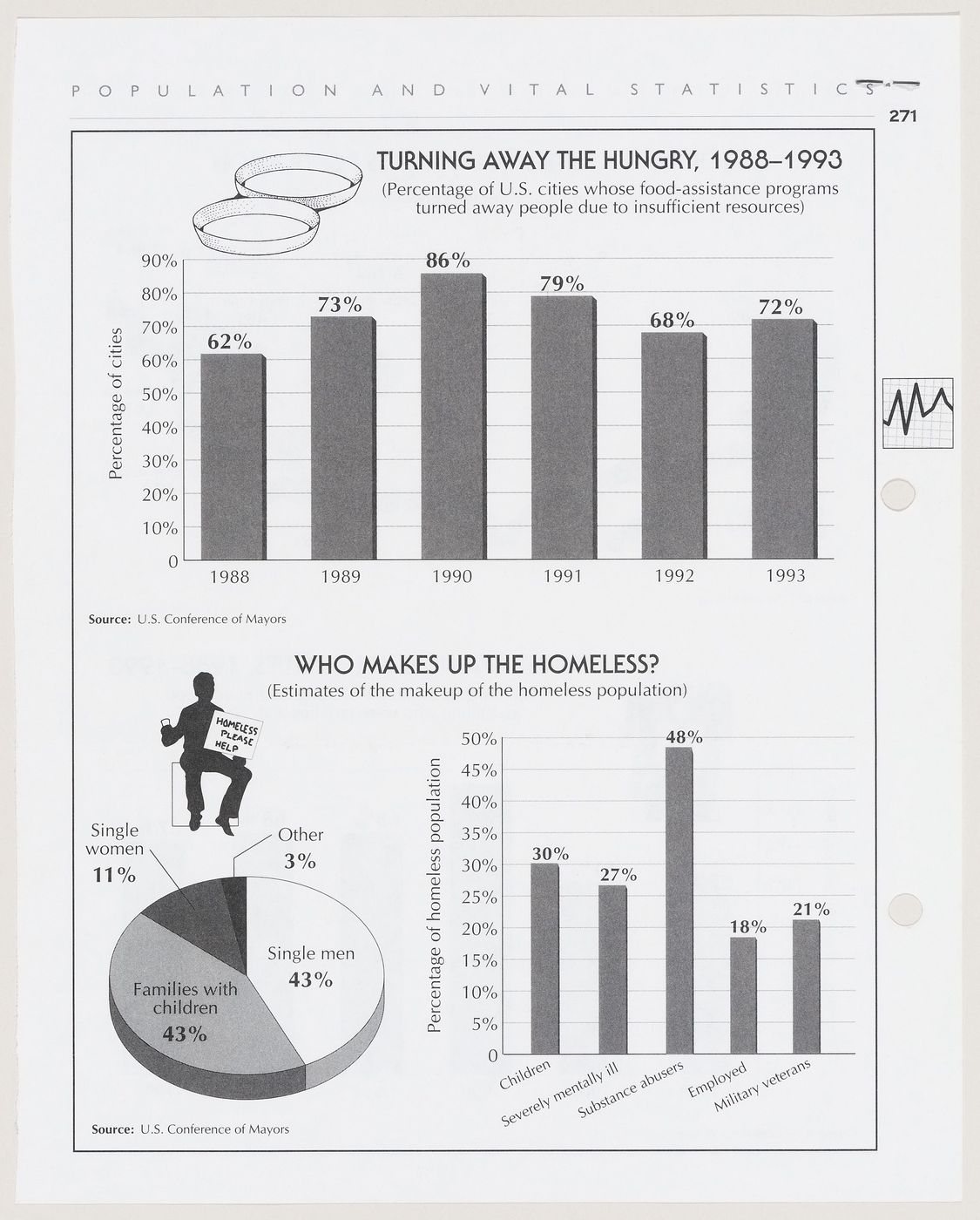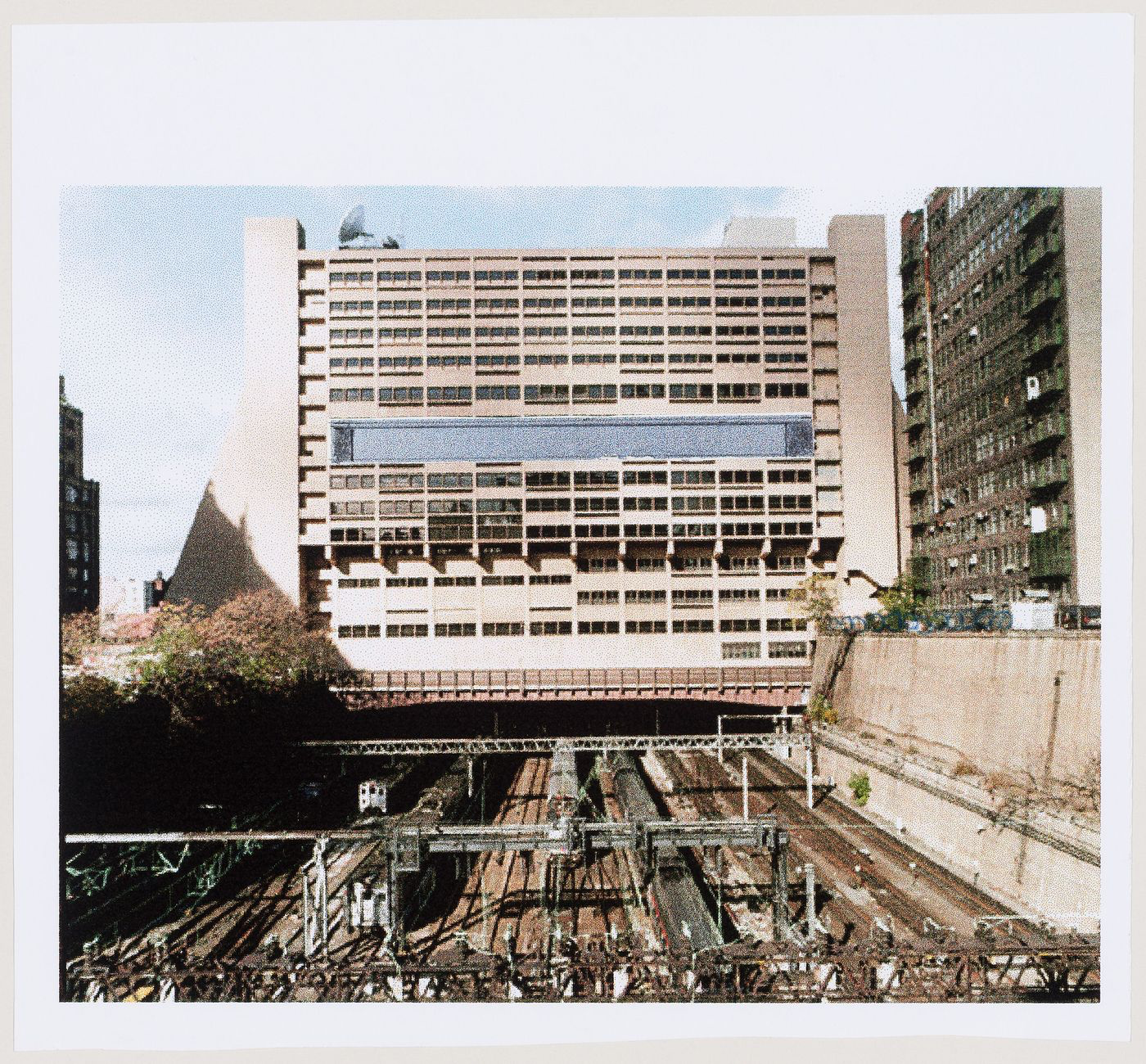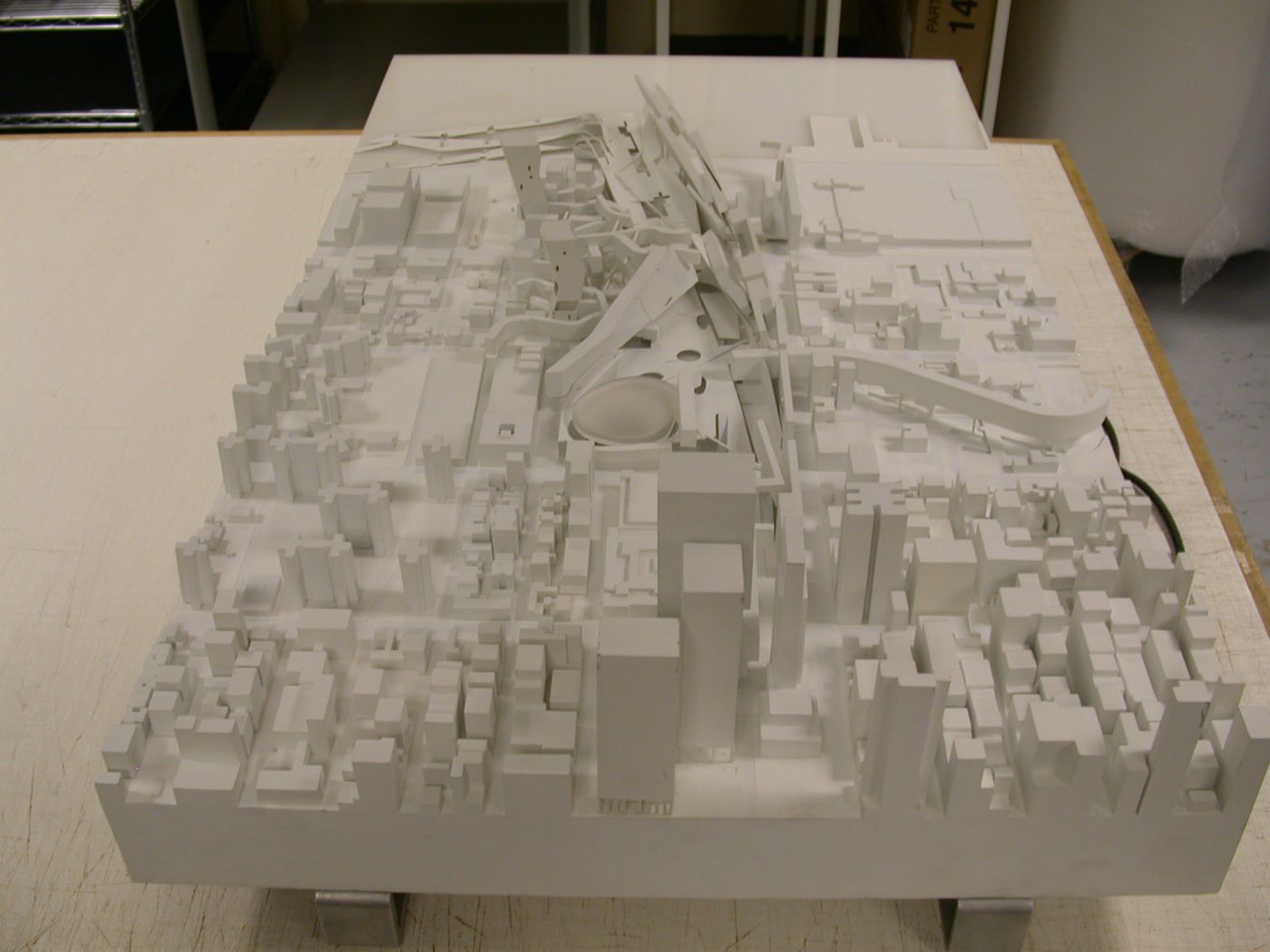The Commons: Manhattan
• Header from an article illustrating Cedric Price's entry to the IFCCA Prize Competition for the Design of Cities, 1999
- “I think that a clear and beautiful idea becomes politically stronger and stronger with time."
- (Mike Nichols, Letter to Cedric Price dated 19 October 1999)
[edit] INTRODUCTION
The first thing is the title — 'The Commons: Manhattan'.
The 'commons' is a term in political economy. It may be defined as:—
- "...the cultural and natural resources accessible to all members of a society, including natural materials such as air, water, and a habitable Earth."
- (Wikipedia)
'Manhattan' is an island where the commons is becoming increasingly depleted.
Thus this article is about replenishing the commons in Manhattan. For example:—
(1) Cedric Price's IFPRI project identified a critical need for replenished commons in Midtown Manhattan, namely:—
- the four essential things humans need in order to survive — i.e. air, water, food and shelter.
- (Cedric Price, after International Food Policy Research Institute) [1]
(2) Cedric Price also focused on air as the most essential resource and proposed a solution, namely:—
- 'A Lung for Midtown Manhattan'
- (Cedric Price, 1999) [2]
(3) Cedric Price concluded:—
- "...this was the only way, in a crowded area of Manhattan, that you could guarantee the future use or under-use of a large area of land."
- (Cedric Price, 2000, in Re:CP) [3]
Thus the purpose of this article is:—
- to take the IFPRI project out of the archive in order to enable others to pick up the argument and propose new testing grounds.
[edit] (1) IFPRI
The International Food Policy Research Institute (IFPRI) researches the essential things humans need in order to survive, namely:—
|
According to Wikipedia:—
However, as noted above, the IFPRI does not study food in isolation from the other essential things humans need in order to survive. |
The IFPRI Headquarters (green) are located in Washington DC and its 8 offices (yellow) are all located in Africa part of Asia. IFPRI According to the CCA, the location of the IFPRI project by Cedric Price was "Manhattan New York (City) New York United States". CCA |
According to the IFPRI File in the Cedric Price fonds held by the Canadian Centre for Architecture:—
- "Material in this file was produced between 1987 and 1988, and between 1999 and 2001, but predominantly in 1999." [1]
 • Location of the competition site (red) on the edge of western Manhattan • Location of the competition site (red) on the edge of western Manhattan
|
 • Location of Midtown Manhatten (grey) • Location of Midtown Manhatten (grey)
|
nb According to Wikipedia:—
- "Midtown spans the entire island of Manhattan along an east–west axis, bounded by the East River on its east and the Hudson River to its west." Wikipedia
|
• Statistics related to the top ten American cities in homeless population and statistics related to hungry families in U.S. cities (document from the IFPRI project records) |
 Statistics related to U.S. cities whose food-assistance programs turned people away due to insufficient resources and statistics related to the makeup of the homeless population (document from the IFPRI project records) Statistics related to U.S. cities whose food-assistance programs turned people away due to insufficient resources and statistics related to the makeup of the homeless population (document from the IFPRI project records)
|
• Table 1: Statistics on food and shelter sourced by the U.S. Conference of Mayors
The digitized items from the IFPRI file shown in Table 1 are evidence of Cedric Price's interest in replenishing the commons.
Thus the major premise affirms some relation between the critical need for replenished commons and Midtown Manhattan.
[edit] (2) 'A Lung for Midtown Manhattan'
In 1998, the International Foundation of the Canadian Centre for Architecture (IFCCA) Prize, proposed by Phyllis Lambert, was initiated as an ideas competition to re-design a site on the edge of western Manhattan, New York City, New York. Following the call for submission to the competition on 13 November 1998 (Stage 1), Cedric Price Architects submitted a proposal, namely:—
- 'A Lung for Midtown Manhattan'
On 10 February 1999, Cedric Price Architects were one of the five finalists selected to progress to the final stage. See Appendix 2.
[edit] • Conceptual sketch
(Cedric Price, 'A Lung for Midtown Manhattan') |
• conceptual sketch incorporating a panoramic view of the site in Western Manhattan, New York, New York |
[edit] • Map of Manhattan
(ib.) |
• Map of Manhattan with site for the IFCCA Prize for the Design of Cities competition and other landmarks highlighted |
[edit] • Bird's eye perspective
|
• bird's eye perspective sketch of the site looking east from the Hudson River |
[edit] • Sketches
|
[edit] • The Hudson Sleeve
|
• view of site from south with proposed Hudson Sleeve, laser transmission tower, southern extension to Javits Convention Center and City Sleeve |
[edit] • The City Sleeve
|
• view of the Hudson Sleeve near the Jacob K. Javits Convention Center |
[edit] • The Wind Blinkers
|
• perspective view looking east from the Hudson River |
[edit] • The Westyard Building
|
• presentation sketch for modification to the Westyard Building |
[edit] • Javits Convention Center South Extension
|
• view of site with proposed structures (laser transmission tower, Hudson Sleeve, Javits Convention Center South Extension and City Sleeve) |

|
• Table 2: Images from the online article illustrating Cedric Price's entry to the IFCCA Prize Competition - see also the header at the top of this article
Thus this premise links the solution — i.e. "A Lung" — to the site — i.e. "Midtown Manhattan".
[edit] (3) CONCLUSION
In September 2000, Hans Ulrich Obrist interviewed Cedric Price:—
- "You recently worked on a new urban project for New York. Five architects and urbanists were invited to rethink an area of the West Side of Manhattan."
- (Hans Ulrich Obrist)
- "I wasn't the winner. I'm not surprised, because mine required commitment for a very long time. It was suggesting that this area of the West Side was the last vacant area allowing fresh air to come off the river, and therefore they should do very little with it; the last thing they should do was cover the railway and build over it. But all the other schemes did just that; they built a stadium, a thirty-thousand-seater centre for something - always something unspecified for architects. I would have been delighted to win, but knowing the jury and knowing New York, the short-term advantage took preference over anything else. The jury, Frank Gehry, Philip Johnson, Phyllis Lambert and various other people, awarded the prize to another man [Peter Eisenman] who did the normal, predictable thing."
- (Cedric Price)
- "Your project for New York is about being fluid, not to be stuck in an identity overkill, the city becoming more and more a museum. Your proposal was more about life than about dead masses of buildings. What role did the river play in your ideas?
- (Hans Ulrich Obrist)
- "Well, the Hudson River is cleaning up all the time in any case. It's a fresh water river, and therefore I was aware of the vast amount of water running down the Hudson and into the ocean. And the winds are from the south-west and west, so the conditions were ideal without anything. The last thing I wanted to do was to increase the foul static nature of the air by producing more buildings. New York suffers from over-development. They had a recent history of schemes that failed or weren't developed, but they see an advantage in short-terms. This competition is being held every two years, so next year it will be another city. It's about the future of cities, but the key word was the "future" of cities, not the past or the present of cities, and this was the only way, in a crowded area of Manhattan, that you could guarantee the future use or under-use of a large area of land."
- (Cedric Price)
Thus this article concludes:—
- ... that it is time for IFPRI 2. [4]
[edit] Notes
[1] Price, C. (1987-2001) 'IFPRI', Canadian Centre for Architecture. See also IFPRI (2023) 'International Food Policy Research Institute' — use the search bar for further information.
[2] Price, C. (1999) 'A Lung for Midtown Manhattan', Canadian Centre for Architecture.
[3] Price, C., ed. Obrich, H. U. (2003) 'Re:CP', Birkhäuser.
[4] Fellows, N. (2024) 'IFPRI 2', wordpress.com
[edit] References
'International Food Policy Research Institute' (2023) 'Search IFPRI Web', ifpri.org
Canadian Centre for Architecture (2004) 'A Lung for Midtown Manhattan: Cedric Price's entry to the IFCCA Prize Competition for the Design of Cities, 1999'.
Morris, S. (2018) 'Cedric Price's Fun Palace comes to life in a moveable exhibit at Prelude to The Shed', The Architect's Newspaper.
Unattributed (2023) 'Commons', Wikipedia.
Unattributed (2023) 'Hudson Yards', Wikipedia.
Unattributed (2023) 'Midtown Manhatten', Wikipedia.
Vickers, G. ed. (1968) 'Value Systems and Social Process', Tavistock Press - copy in the Internet Archive at archive.org
[edit] Further Reading
Arup (2024) 'Tall buildings: rising to the net zero challenge', arup.com
DLD Conference (2018) 'Space On Demand: Designing The Shed (Elizabeth Diller & Hans Ulrich Obrist) | DLD New York 18', YouTube.
Hardingham, S., ed. (2003) 'Cedric Price Opera', Wiley.
Hardingham, S., ed. (2016) 'Cedric Price Works 1952-2003: A Forward-Minded Retrospective - Projects', pp.844-851, Architectural Association, London and Canadian Centre for Architecture, Montreal.
Hayward, P. (2015) 'The Aquapelago and the Estuarine City: Reflections on Manhattan', researchgate.net
Muschamp, H. (1999) 'CRITIC'S NOTEBOOK; Design Fantasies for a strip of the West Side', The New York Times. Also on extremelyprovocative.wordpress.com
Price, C. (1999) 'Message (fax) from Cedric Price addressed to the IFCCA Prize Coordinator (document from the IFPRI project records)', Cedric Price fonds, CCA.
reSITE (2017) 'James Corner on Why Public Spaces Need Creativity and Design', YouTube.
Sypher, F. J. (2015) 'The Schagen Letter', New Amsterdam History Center.
TED (2021) 'A stealthy reimagining of urban public space | Elizabeth Diller', YouTube.
Unattributed (2023) '1626: Purchase of the Island of Mannahatta', History101.nyc.
Zhang, M. (2018) 'The New York City Evolution Animation', YouTube.
Zhang, M. (2021) 'The Privatization of Public Space in Lower Manhattan', myleszhang.org
[edit] Appendix 1 - IFPRI in CP OPERA

|

|
• Table 3: IFPRI spread in 'Cedric Price Opera' - nb A request to the Publisher to use these extracts has been emailed to [email protected]
nb This spread includes the letter to Cedric Price from Mike Nichols.
[edit] Appendix 2 - IFCCA Prize Competition
Secondly, on 13 November 1998, the International Foundation of the Canadian Centre for Architecture (IFCCA) put out the call for submission to the Canadian Centre for Architecture (IFCCA) Prize Competition, also known as the CCA Competition for the Design of Cities. The Prize was initiated as an ideas competition to re-design a site on the edge of western Manhattan, New York City, New York.
|
• Axonometric of Manhattan for IFPRI by Cedric Price |
• The IFCCA Prize Competion site, West Side. Source: The New York Times |
THE FIVE FINALISTS IN THE IFCCA PRIZE COMPETITION
According to CCA:—
- "Over 100 proposals from architectural firms around the world were received following the call from submission 13 November 1998 (Stage 1). On 10 February 1999, five finalists were selected to continue to the final stage: Peter Eisenman, Peter Eisenman Architects, New York City; Thom Mayne, Morphosis, Santa Monica, California; Ben van Berkel and Caroline Bos, UN Studio Van Berkel & Bos, Amsterdam, the Netherlands; Cedric Price, Cedric Price Architects, London, England; Jesse Reiser and Nanako Umemoto, Reiser + Umemoto RUR Architecture, New York City."
In October 1999, an exhibition of new designs for the redevelopment of the far West Side of mid-Manhattan was held in Vanderbilt Hall, the former waiting room at Grand Central Terminal - see Table 3 below.
• Table 3: Selected images illustrating schemes entered by the finalists
The IFCCA Prize Jury was made up of well known figures in both the architecture and city planning fields, namely:—:
- Elizabeth Diller, of the cross-disciplinary studio Diller + Scofidio;
- Phyllis Lambert, Founding Director of the CCA;
- Frank Gehry, design principal for Frank O. Gehry and Associates, Inc.;
- Charles A. Gargano, Chairman and Commissioner of Empire State Development and now U.S. Ambassador to Austria;
- Gary Hack, Professor of City and Urban Planning and Dean of the Graduate school of Fine Arts at the University of Pennsylvania;
- Arata Isozaki, Arata Isozaki and Associates;
- Philip Johnson, architect;
- José Rafael Moneo, architect and Josep Lluis Sert Professor of Architecture, Harvard University Graduate School of Design;
- Joseph B. Rose, Chairman of New York City Planning Commission and Director of the Department of City Planning, now partner in Georgetown Group.
The jury awarded the prize to Peter Eisenman's entry.
According to Susan Morris:—
- "(Elizabeth) Diller voted for Price’s entry, which proposed leaving the space open with “wind-blinkers” to encourage breezes from the river to waft over Manhattan."
[edit] Appendix 3 - Herbert Muschamp's Notebook
On October 18 1999, the New York Times published an article by Herbert Muschamp. It included the following comments:—[+]
|
• Table 4: Extracts from 'CRITIC'S NOTEBOOK; Design Fantasies for a strip of the West Side' by Herbert Muschamp
[edit] Footnote
- “If Mannahatta existed today as it did then, it would be a national park – it would be the crowning glory of American national parks."
- (Dr. Eric Sanderson, Mannahatta: The Natural History of New York)
--Archiblog 06:15, 15 Dec 2023 (BST)
[edit] Related articles on Designing Buildings
Featured articles and news
One of the most impressive Victorian architects. Book review.
RTPI leader to become new CIOB Chief Executive Officer
Dr Victoria Hills MRTPI, FICE to take over after Caroline Gumble’s departure.
Social and affordable housing, a long term plan for delivery
The “Delivering a Decade of Renewal for Social and Affordable Housing” strategy sets out future path.
A change to adoptive architecture
Effects of global weather warming on architectural detailing, material choice and human interaction.
The proposed publicly owned and backed subsidiary of Homes England, to facilitate new homes.
How big is the problem and what can we do to mitigate the effects?
Overheating guidance and tools for building designers
A number of cool guides to help with the heat.
The UK's Modern Industrial Strategy: A 10 year plan
Previous consultation criticism, current key elements and general support with some persisting reservations.
Building Safety Regulator reforms
New roles, new staff and a new fast track service pave the way for a single construction regulator.
Architectural Technologist CPDs and Communications
CIAT CPD… and how you can do it!
Cooling centres and cool spaces
Managing extreme heat in cities by directing the public to places for heat stress relief and water sources.
Winter gardens: A brief history and warm variations
Extending the season with glass in different forms and terms.
Restoring Great Yarmouth's Winter Gardens
Transforming one of the least sustainable constructions imaginable.
Construction Skills Mission Board launch sector drive
Newly formed government and industry collaboration set strategy for recruiting an additional 100,000 construction workers a year.
New Architects Code comes into effect in September 2025
ARB Architects Code of Conduct and Practice available with ongoing consultation regarding guidance.
Welsh Skills Body (Medr) launches ambitious plan
The new skills body brings together funding and regulation of tertiary education and research for the devolved nation.
Paul Gandy FCIOB announced as next CIOB President
Former Tilbury Douglas CEO takes helm.












































